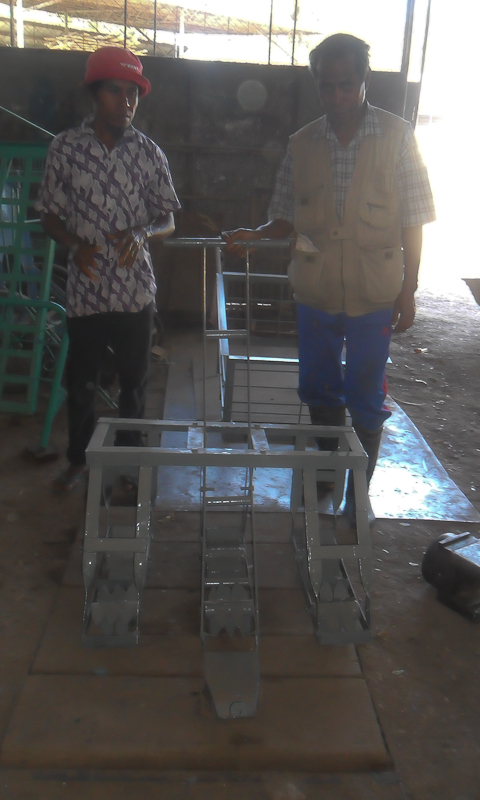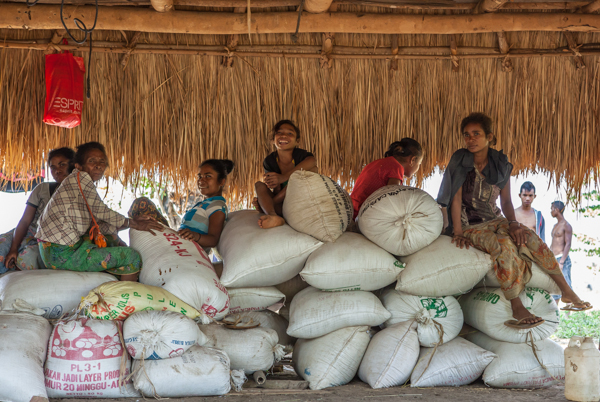
SRI rice generates more stalks (pinnacles) than conventionally planted rice and gives bigger yields per hectare
MCE-A through OXFAM Timor-Leste with the support of OXFAM NZ began SRI trials at 16 sites (totalling 30 hectares (HA) of land) throughout Timor-Leste. The SRI team formed gained in knowledge and experience and provided much needed information and documentation which played its part with OXFAM New Zealand’s successful proposal to the NZ Foreign Affairs and Trade Aid programme, to be implemented over the next 5 years.
The SRI Rice trials were revealing; of the initial harvests in June-July 2013, a substantial increase in farmers’ income and productivity per area was achieved. Reports from all implemented sites at their different stages of growth are also indicating that they are on a similar track. Even in areas where there were adverse conditions such lack of sufficient water causing food shortages, the SRI result still demonstrated a substantial increase in productivity compared to even ICM sites in the same area.
The areas that have been and are being trialed are: 1.Bacau 1 HA, 2.Suai- Bago uno oan 1 HA, 3.Fitun Nabilan 3 HA, Beco Yes, 4.Halek 3 HA, 5. Mota Kiar Holbelak 2 HA, 6. Apapolo 2 HA, 7. Pemuda 2 HA, 8. Haburas Saree 1 HA, 9. Ramaskola 4 HA, 10. Maumali 3 HA, 11. Sekar 2 HA, 12. Seloi 1 HA, 13. Same 1 HA, 14. Watulari-Incosta-Mestri 2 HA, 15. Watulari Ossu 2 HA, 16. Watulari Laihunuu 1 HA

Rice harvest dehusked and bagged in Haburas Sare
Trials are indicating an average of 58 rice pinnacles (stalks) per plant compared to 10 in the traditional method. The following case study is of the trial at Haburas Sare June 2013 which is one of three sites that have been harvested so far.

Women coop members weed the crop while it is growing and help hand cut the rice at harvest time
The total yield of processed rice was 76 X 25 kg bags and one kilo, or 1,901 kilos. As presented below. 1901/5,147 (Area) =.39Kgs per M2 or 3.693 tons per hectare of processed marketable rice. It is recognised that the trial hasn’t reached its potential yet however the yield represented a six fold increase on the conventional system used in the area and dramatically outperformed ICM. Critical information about the program’s capability has been obtained.
MCEA through SAL bought the 76 X 25 kg bags above from the trial at 65 cents a kilo or $1,235 for the 1.9 tons. This was income that a very poor community would not have otherwise earned. The community has since begun to organize itself to implement over 20 HA in the next planting season. MCEA has since through SAL organized to sell and distribute the rice.
The work Integrated well with OXFAM’s GROW campaign and has attracted the attention of both the Minister Marian Assanami Sabino and Vice Minister of Agriculture, Marcos De Cruz. The Vice Minister met MCEA staff, cooperative members and Oxfam partners during this event and requested from M K Ali (OXFAM TL Country director) a presentation from OXFAM. The Minister of Agriculture has requested to visit sites in Suai which we are also pleased to present.

The Director of MCE-A, Jose AMX Goncalves and Vice Minister for Agricuture and Fisheries Marcos da Cruz at OXFAM’s GROW campaign
Cooperation between MCEA and Government extension officers has begun in earnest in Sekar -Maliana with a joint project opening up a three kilometer water way using government equipment.
“The trials in Sekar have the potential to open up 200 Ha to rice cultivation where that had not previously been possible” says Mr. Jose AMX Goncalves, Director of MCE-A. “In all, 9 Ha have been put in SRI in Maliana to date. Discussions and plans between MCEA and the government continue to integrate, which we hope will be included in the design for next year, including items such as warehousing, logistics and large tracks of paddy implementation.”

Successful harvest sold at 65c per kg. Next year will be even better!
The increase in productivity resulted in a cash sale which was before not possible. The mobilisation of the community to get to that point and the wealth injected into the community vitalises communities with a genuine desire to keep going as they prove to themselves that they can transform their community and make the hoped-for progress happen – that is what they are doing with the implementation. It also sets the scene for the larger planned movement of increased production and economic sovereignty which is attractive to stakeholders and members alike.
Vital measures in terms of productivity and costs have also been learnt in terms of both planning and implementation which are vital for further planning. Skills by administrators and implementers alike have been sharpened with the experience and perhaps most vitally at this stage relationships with members and partners have been formed and strengthened giving purpose to further training and integration.

















